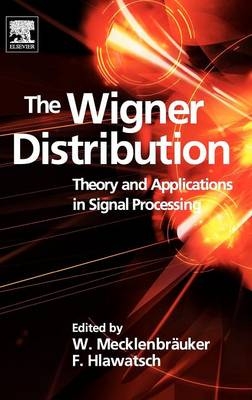
The Wigner Distribution
Elsevier Science Ltd (Verlag)
978-0-444-88856-3 (ISBN)
- Titel ist leider vergriffen;
keine Neuauflage - Artikel merken
In the last two decades, the field of time-frequency analysis has evolved into a widely recognized and applied discipline of signal processing. Besides linear time-frequency representations such as the short-time Fourier transform, the Gabor transform, and the wavelet transform, an important contribution to this development has undoubtedly been the Wigner distribution (WD) which holds an exceptional position within the field of bilinear/quadratic time-frequency representations.The WD was first defined in quantum mechanics as early as 1932 by the later Nobel laureate E. Wigner. In 1948, J. Ville introduced this concept in signal analysis. Based on investigations of its mathematical structure and properties by N.G. de Bruijn in 1967, the WD was brought to the attention of a larger signal processing community in 1980. The WD was soon recognized to be important for two reasons: firstly, it provides a powerful theoretical basis for quadratic time-frequency analysis; secondly, its discrete-time form (supplemented by suitable windowing and smoothing) is an eminently practical signal analysis tool.The seven chapters of this book cover a wide range of different aspects of the WD and other linear time-frequency distributions: properties such as positivity, spread, and interference term geometry; signal synthesis methods and their application to signal design, time-frequency filtering, and signal separation; WD based analysis of nonstationary random processes; singular value decompositions and their application to WD based detection and classification; and optical applications of the WD. The size of the chapters has been chosen such that an in-depth treatment of the various topics is achieved.
Positivity and Spread of Bilinear Time-Frequency Distributions (A.J.E.M. Janssen). Introduction. Cohen's class of bilinear time-frequency distributions. Time-frequency distributions and spread. Positivity properties of the Wigner distribution. Theorems of the Hudson type for Wigner-Rihaczek distributions. Wigner type theorems for bilinear time-frequency distributions. Smoothing bilinear time-frequency distributions. Some additional results and further developments. References. The Interference Structure of the Wigner Distribution and Related Time-Frequency Signal Representations (F. Hlawatsch, P. Flandrin). Introduction. Part I - Wigner Distribution Outer interference. Interference geometry. Energetic interpretation of interference terms. Inner interference . The stationary-phase approximation. Singularities of interference terms. Sampling and aliasing. Part II - Related Time-Frequency Representations. Generalized Wigner distribution. Ambiguity function. The shift-invariant class. The shift-scale-invariant class. Smoothed versions of Wigner distribution. Conclusion. References. Signal Synthesis Algorithms for Bilinear Time-Frequency Signal Representations (F. Hlawatsch, W. Krattenthaler) Introduction. Subspace-unitary bilinear time-frequency representations. Wigner distribution. Smoothed versions of Wigner distribution. Spectrogram. On-line synthesis algorithms for pseudo Wigner distribution. Phase matching algorithms. Applications to time-frequency filtering. Conclusion. References. The Wigner-Ville Spectrum of Nonstationary Random Signals (P. Flandrin, W. Martin) Introduction. Stationarity and nonstationarity. Definitions of time-dependent spectra. The Wigner-Ville spectrum. Estimation of the Wigner-Ville spectrum. Wigner-Ville based optimum detection. Conclusion. References. Time-Varying Signal Processing Using Wigner Distribution Synthesis Techniques (G.F. Boudreaux-Bartels) Introduction. Time-varying signal processing applications of WD synthesis techniques. Cross Wigner distribution synthesis. Conclusions. Acknowledgements. References. The Singular Value Decomposition of the Wigner Distribution and its Applications (N.M. Marinovich) Introduction. Outer product expansion of the Wigner distribution. Application to shape description and classification. Application to biomedical ultrasonic tissue characterization. Generalized SVD of the Wigner distribution - application to signal detection. Summary. References. Application of the Wigner Distribution Function in Optics (M.J. Bastiaans) Introduction. Wigner distribution function as a local frequency spectrum. Examples of Wigner distribution functions. Properties of the Wigner distribution function. Ray spread function of an optical system. Transport equations for the Wigner distribution function. Wigner distribution function for partially coherent light. Applications of the Wigner distribution function in optics. Appendices. References. Bibliography for the years from 1985-1992. Subject index.
| Erscheint lt. Verlag | 8.10.1997 |
|---|---|
| Zusatzinfo | bibliog , references, index |
| Verlagsort | Oxford |
| Sprache | englisch |
| Gewicht | 1030 g |
| Themenwelt | Informatik ► Grafik / Design ► Digitale Bildverarbeitung |
| Technik ► Nachrichtentechnik | |
| ISBN-10 | 0-444-88856-X / 044488856X |
| ISBN-13 | 978-0-444-88856-3 / 9780444888563 |
| Zustand | Neuware |
| Haben Sie eine Frage zum Produkt? |
aus dem Bereich


